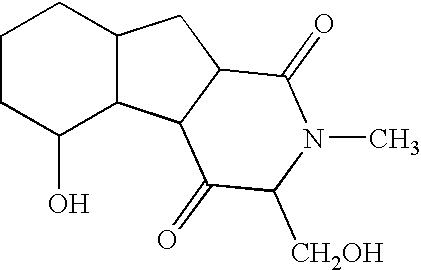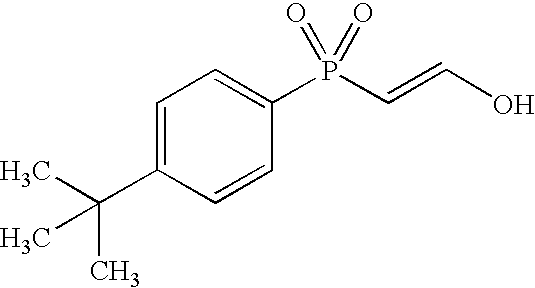Inhibitors of proteasomal activity for stimulating hair growth
a proteasomal activity and inhibition technology, applied in the direction of peptide/protein ingredients, depsipeptides, peptide sources, etc., can solve the problems of modest efficacy, inconvenient administration, common and distressing, etc., and achieve the effect of stimulating hair growth and lowering the level of effective expression of nucleotide sequences
- Summary
- Abstract
- Description
- Claims
- Application Information
AI Technical Summary
Benefits of technology
Problems solved by technology
Method used
Image
Examples
example 1
Effect of PSI and Other Proteasome Inhibitors on Hair Follicle Production
[0057]The in vivo bone calvarial growth assay of Example 3 was modified to observe the number of hair follicles in treated mice. In initial observations, PSI (5 mg / kg / day) was injected three times a day for 5 days over the calvaria of Swiss ICR mice as described above. Sixteen days later the mice were sacrificed. Histology of the calvaria revealed a strikingly large increase in the number of hair follicles in those mice treated with PSI versus control mice. In addition to PSI, MG132 (10 mg / kg), MG115 (10 mg / kg) and lactacysin administered in the same way also stimulated an increase in the number of hair follicles.
[0058]The compound useful in the present methods can be lactacystin or a peptidyl aldehyde.
example 2
Stimulation of Hair Growth
[0059]Male Swiss ICR mice were first treated to remove hair from the scalp and dorsal regions as follows. Paraffin wax was liquefied by heating to 55° C. and the liquefied wax then applied by brush to the scalp and / or back (under anesthesia). The wax was allowed to solidify and then removed. The day following hair stripping, PSI (1 mg / kg / day) was injected subcutaneously three times a day for five days into the scalp and dorsal region. On day 7 a dermal punch biopsy was taken; histology revealed a large increase in the number of hair follicles in mice administered PSI versus control mice. By day 18, it was observable that the treated mice had a hair growth rate greater than that of the mice in the control group.
[0060]The mice were sacrificed on day 21 and histology was performed on the dermis of the scalp and of the dorsal region. In the treated mice, mature hair follicles in numbers much greater than in controls had migrated to the lower region of the dermi...
example 3
Topical Administration
[0061]PSI was prepared as a topical formulation, where the vehicle was 50% propylene glycol, 30% ethanol, 20% deionized water, at 0.1% concentration of PSI. The solution was applied 3 times a day for 5 days. The mice in a treated group were observed as compared to controls similarly treated with vehicle alone. The results at day 16 showed stimulation of hair growth relative to the controls.
[0062]In addition to stimulating hair growth, PSI was able to thicken both the hair and the hair shaft. PSI increases hair count when the follicle area is greater than 0.01 mm2. When the protocol above was repeated using a 0.5% solution of PSI in groups containing 5 mice each, the number of hairs per 0.8 mm2 was 60 in the treated mice versus about 10 in the control group. The percentage of follicle area in a region of about 0.8 mm2 was about 30% as an average in the treated group as compared to 15% as an average in the control group.
PUM
| Property | Measurement | Unit |
|---|---|---|
| Temperature | aaaaa | aaaaa |
| Length | aaaaa | aaaaa |
| Thickness | aaaaa | aaaaa |
Abstract
Description
Claims
Application Information
 Login to View More
Login to View More - R&D
- Intellectual Property
- Life Sciences
- Materials
- Tech Scout
- Unparalleled Data Quality
- Higher Quality Content
- 60% Fewer Hallucinations
Browse by: Latest US Patents, China's latest patents, Technical Efficacy Thesaurus, Application Domain, Technology Topic, Popular Technical Reports.
© 2025 PatSnap. All rights reserved.Legal|Privacy policy|Modern Slavery Act Transparency Statement|Sitemap|About US| Contact US: help@patsnap.com



